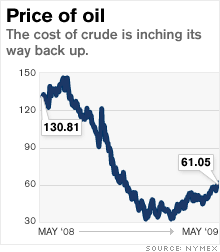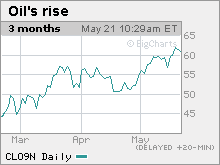$60 - oil's sweet spot
Rising crude prices shouldn't derail any economic recovery, and may prevent a super spike later on.


NEW YORK (CNNMoney.com) -- You've probably noticed it at the gas pump.
$1.88, $2.01, $2.21. Price data from the government over the last few weeks clearly show gas is on the rise. On Thursday it averaged $2.36 a gallon, according to the motorist organization AAA.
Gasoline prices rise with oil prices, which have also been on the march lately. On Wednesday they settled above $60 a barrel for the first time in six months.
There's been talk that these rising oil and gas prices may derail any budding economic recovery, as consumers put more money in their tank and less into their local economy.
But most experts say $60 oil isn't too much of a burden, and this mid-range price could ultimately prevent future spikes.
"This is a price level the U.S. economy can shoulder," said John Lonski, chief economist at Moody's Analytics. "It will not figure into the timing of the recovery."
Talk of a budding economic recovery isn't just talk, there are concrete numbers backing it up.
While unemployment remains high, fewer people have been filing new claims. Leading indicators ticked higher in April. And the Treasury yield curve is widening. Oil prices, which have been tracking the stock markets lately, rose mostly on news like this.
It's not unreasonable to think rising oil prices could snuff out these signs of hope. Unlike previous recessions, oil prices are much more closely aligned with stock prices, as commodities have became a popular investment vehicle.
"People think the price of crude is reflective of fundamentals, but more and more it's reflective of the economic expectations of the financial community," said Tom Kloza, chief oil analyst for the Oil Price Information Service, which gathers data for AAA.
This isn't necessarily a bad thing, but it does mean oil prices now rise along side stocks, which generally rise on the expectations of a recovery, not when the recovery actually kicks in.
But this aside, oil and gas prices are still well below where they were last year, and probably have substantial room to go higher before they start to hit consumer spending or sentiment.
Lonski said it would take gas around $3 a gallon, and oil prices near $100 a barrel before it had a wider impact on the economy.
Fortunately for drivers, and maybe the wider economy as a whole, most analysts don't think we're going there anytime soon.
For one thing, even though expectations of a recovery are higher, the fundamentals for crude remain terrible. There's much more supply than demand.
For another, oil and gas prices always rise this time of year in expectation for the summer driving season, so this recent gain isn't unexpected.
The rise this year has been the largest in history on a percentage basis, with retail gas prices up almost 50% since late last year and gasoline futures prices up a whopping $138%, said Kloza.
Because of this huge runup, and with summer driving season almost here, he thinks the price rally may be done.
"The numbers we saw yesterday might be the spring peak," said Kloza.
If he's right and oil doesn't runup too much higher or fall too much lower, it could be a blessing for everyone.
Oil at $60 a barrel, as opposed to the high $30s we saw earlier this year, is good if you're hoping for an economic rebound.
"It testifies that the world economy isn't falling into an abyss," said Lonski.
Moreover, $60 is generally the lowest number oil can sell for that will keep oil companies and countries working to bring new sources to market, said Adam Sieminski, chief energy economist at Deutsche Bank.
"You need $60 to get new investment," he said. "The longer you stay below $60, or even $80, the greater the potential for oil prices to spike and create problems for everyone two years from now."
So $60 seems to be a sweet spot for crude. But as Sieminski was quick to note, oil rarely stays at one price for long. ![]()



